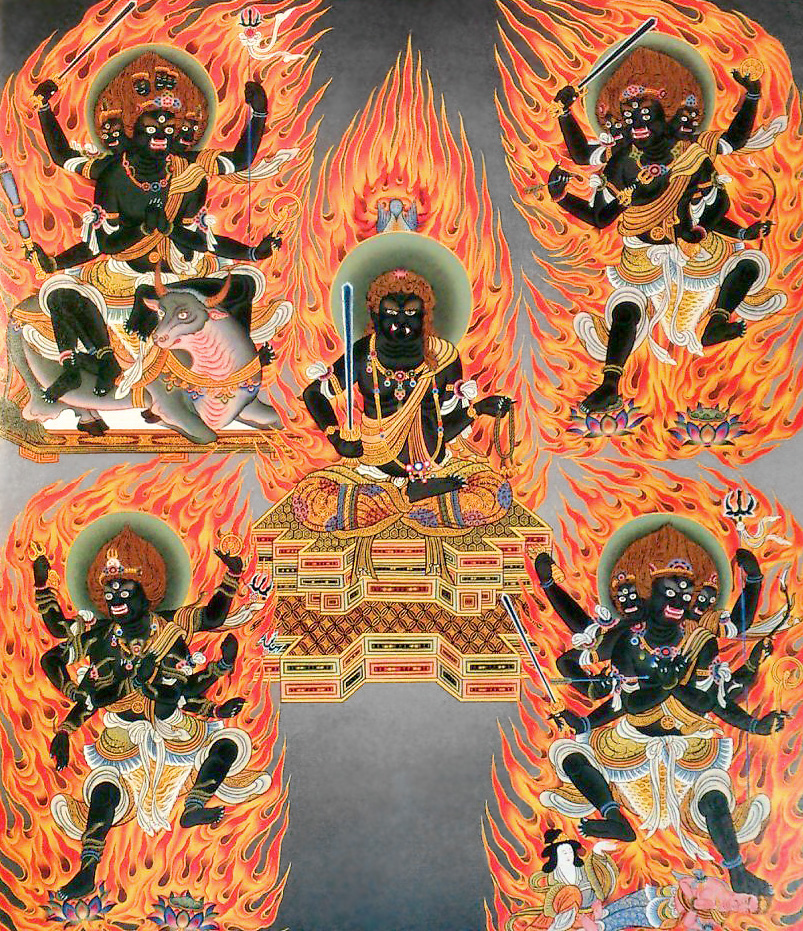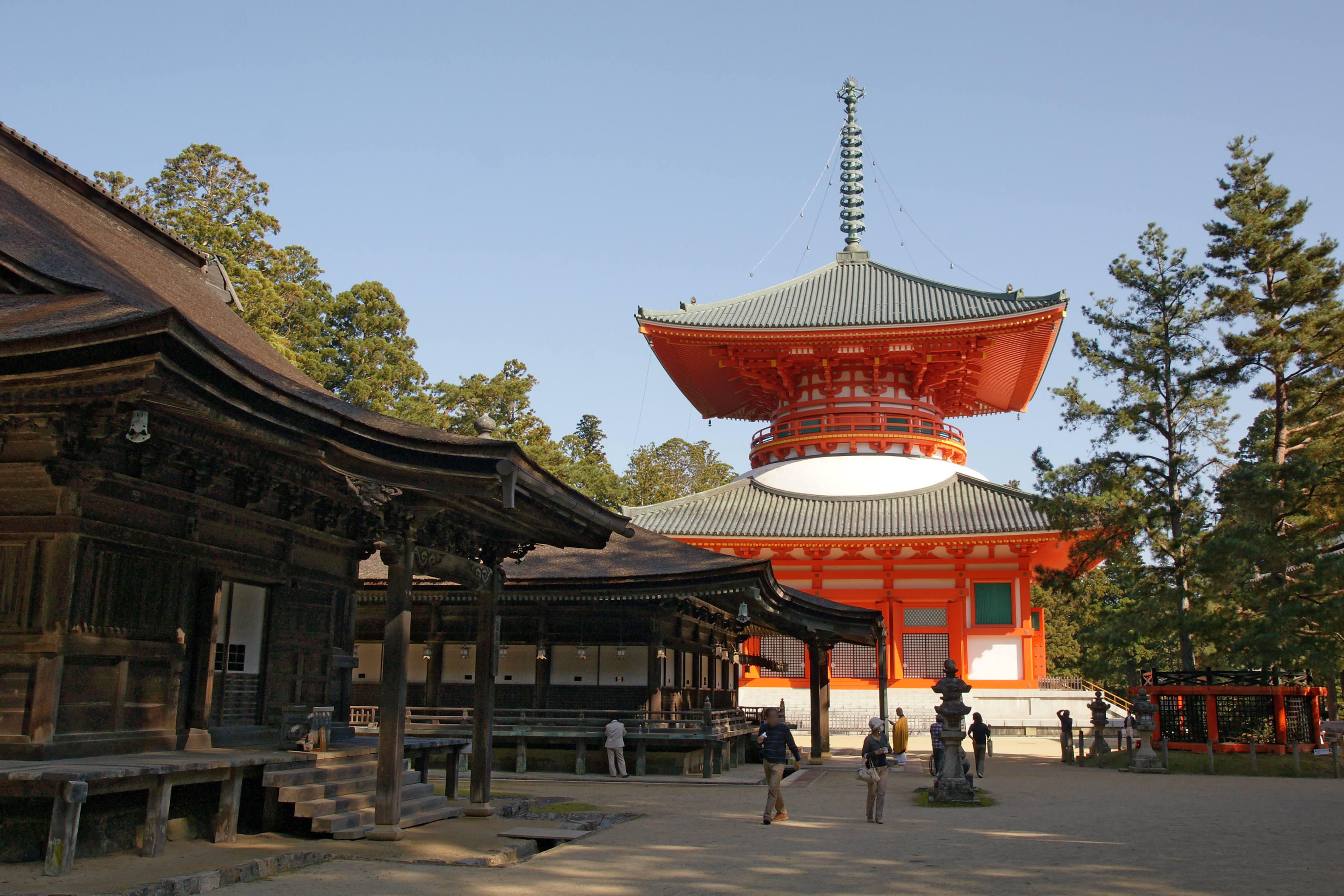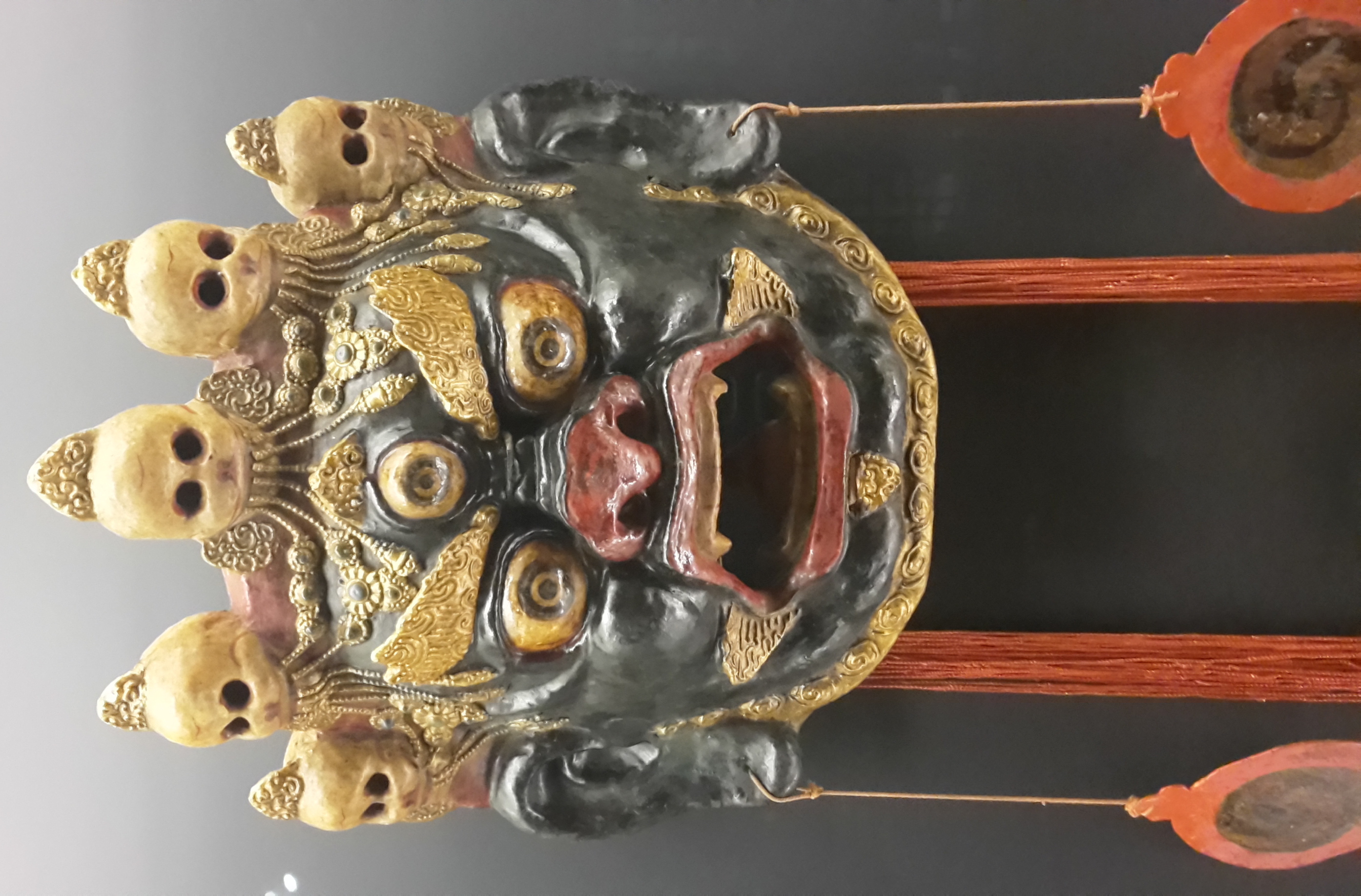|
Acala
or Achala (, "The Immovable", ), also known as (, "Immovable Lord") or (, "Noble Immovable Lord"), is a Fierce deities, wrathful deity and ''dharmapala'' (protector of the Dharma) prominent in Vajrayana, Vajrayana Buddhism and East Asian Buddhism., Jp. rel. dict., pp. 242–246 Originally a minor deity described as a messenger or acolyte of the Buddhahood, buddha Vairocana, Acala later rose to prominence as an object of veneration in his own right as a remover of obstacles and destroyer of evil, eventually becoming seen as the wrathful manifestation of either Vairocana, the buddha Akshobhya, Akṣobhya, or the bodhisattva Manjushri, Mañjuśrī. In later texts, he is also called (, "Violent Wrathful One", ) or (, "Violent One of Great Wrath", ), the names by which he is more commonly known in countries like Nepal and Tibet. In East Asian Buddhism, East Asian Chinese Esoteric Buddhism, esoteric Buddhism, Acala is classed among the Wisdom Kings () and is preeminent among the ... [...More Info...] [...Related Items...] OR: [Wikipedia] [Google] [Baidu] |
Wisdom King
A wisdom king (Sanskrit: विद्याराज; International Alphabet of Sanskrit Transliteration, IAST: ''vidyārāja'', ) is a type of Wrathful deities, wrathful deity in East Asian Buddhism. Whereas the Sanskrit name is translated literally as "wisdom / knowledge king(s)," the term ''Vidya (philosophy), vidyā'' in Vajrayana Buddhism is also specifically used to denote mantras; the term may thus also be rendered "mantra king(s)." ''Vidyā'' is translated in Chinese with the character wikt:明, 明 (lit. "bright, radiant", figuratively "knowledge(able), wisdom, wise"), leading to a wide array of alternative translations such as "bright king(s)" or "radiant king(s)". A similar category of fierce deities known as herukas are found in Tibetan Buddhism. The female counterparts of wisdom kings are known as wisdom queens (Sanskrit (IAST): ''vidyārājñī'', Chinese: 明妃, ''Míngfēi'', Japanese: ''Myōhi''). Overview Development ''Vidyārājas'', as their name suggests, a ... [...More Info...] [...Related Items...] OR: [Wikipedia] [Google] [Baidu] |
Shingon
is one of the major schools of Buddhism in Japan and one of the few surviving Vajrayana lineages in East Asian Buddhism. It is a form of Japanese Esoteric Buddhism and is sometimes called "Tōmitsu" (東密 lit. "Esoteric [Buddhism] of Tō-ji"). The word ''shingon'' is the Kan-on, Japanese reading of the Traditional Chinese characters, Chinese word ('), which is the translation of the Sanskrit word mantra. The Chinese Esoteric Buddhism, Zhēnyán lineage was founded in China (c. 7th–8th centuries) by Indian Vajracharya, vajrācāryas (esoteric masters) like Śubhakarasiṃha, Vajrabodhi and Amoghavajra. These esoteric teachings would later flourish in Japan under the auspices of a Buddhist monk named Kūkai (, 774–835), who traveled to Tang dynasty, Tang China and received these esoteric transmissions from a Chinese master named Huiguo (746–805). Kūkai established his tradition at Mount Kōya (in Wakayama Prefecture), which remains the central pilgrimage center of Sh ... [...More Info...] [...Related Items...] OR: [Wikipedia] [Google] [Baidu] |
Shugendō
is a syncretic Esoteric Buddhist religion, a body of ascetic practices that originated in the Nara Period of Japan having evolved during the 7th century from an amalgamation of beliefs, philosophies, doctrines and ritual systems drawn primarily from Esoteric Buddhism, local folk-religious practices, Shinto, mountain worship, and Taoism. The final purpose of ''Shugendō'' is for practitioners to find supernatural power and save themselves and the masses by conducting religious training while treading through steep mountain ranges. Practitioners are called or . The mountains where ''shugendo'' is practiced are all over Japan, and can span multiple mountains within one range such as the Ōmine mountain range with Mount Hakkyō and Mount Ōmine or the Ishizuchisan mountain range with Kamegamori and Tengudake. The ''Shugendō'' worldview includes a large pantheon of deities (which include Buddhist and Shinto figures). Some of the most important figures are the tantric B ... [...More Info...] [...Related Items...] OR: [Wikipedia] [Google] [Baidu] |
Khanda (sword)
The khanda () is a double-edge straight sword originating from the Indian subcontinent. The Rajput warrior clans venerated the khanda as a weapon of great prestige. It is often featured in religious iconography, theatre and art depicting the ancient history of India. It is a common weapon in Indian martial arts.M. L. K. Murty (2003), p91 Khanda often appears in Hindu, Jain, Buddhist and Sikh scriptures and art. Etymology The word ''khanda'' has its origins in the Sanskrit 'Rocky Pendergrass, 201Mythological Swords Page 10. (खड्ग) or ', from a root ' meaning "to break, divide, cut, destroy". The older word for a bladed weapon, ', is used in the Rigveda in reference to either an early form of the sword or to a sacrificial knife or dagger to be used in war. Appearance The blade broadens from the hilt to the point, which is usually quite blunt. While both edges are sharp, one side usually has a strengthening plate along most of its length, which both adds weight to downward ... [...More Info...] [...Related Items...] OR: [Wikipedia] [Google] [Baidu] |
Chinese Esoteric Buddhism
Chinese Esoteric Buddhism refers to traditions of Tantra and Vajrayana, Esoteric Buddhism that have flourished among the Chinese people. The Tantric masters Śubhakarasiṃha, Vajrabodhi and Amoghavajra, established the Esoteric Buddhist ''Zhenyan'' (, "true word", "mantra") tradition from 716 to 720 during the reign of Emperor Xuanzong of Tang. It employed mandalas, mantras, mudras, abhisheka, abhiṣekas, and deity yoga. The Zhenyan tradition was transported to Japan as Tendai and Shingon Buddhism by Saichō and Kūkai, as well as influencing Korean Buddhism and Vietnamese Buddhism. The Song dynasty (960–1279) saw a second diffusion of Esoteric texts. Esoteric Buddhist practices continued to have an influence into the late imperial period and Tibetan Buddhism was also influential during the Yuan dynasty period and beyond. In the Ming dynasty (1368–1644) through to the modern period, esoteric practices and teachings became absorbed and merged with the other Chinese Buddhist tradi ... [...More Info...] [...Related Items...] OR: [Wikipedia] [Google] [Baidu] |
Tendai
, also known as the Tendai Dharma Flower School (天台法華宗, ''Tendai hokke shū,'' sometimes just ''Hokkeshū''), is a Mahāyāna Buddhist tradition with significant esoteric elements that was officially established in Japan in 806 by the Japanese monk Saichō. The Tendai school, which has been based on Mount Hiei since its inception, rose to prominence during the Heian period (794–1185). It gradually eclipsed the powerful Hossō school and competed with the rival Shingon school to become the most influential sect at the Imperial court. By the Kamakura period (1185–1333), Tendai had become one of the dominant forms of Japanese Buddhism, with numerous temples and vast landholdings. During the Kamakura period, various monks left Tendai to found new Buddhist schools such as Jōdo-shū, Jōdo Shinshū, Nichiren-shū and Sōtō Zen. The destruction of the head temple of Enryaku-ji by Oda Nobunaga in 1571, as well as the geographic shift of the capital away from ... [...More Info...] [...Related Items...] OR: [Wikipedia] [Google] [Baidu] |
Dharmapala
A ''dharmapāla'' is a type of wrathful god in Buddhism. The name means "''dharma'' protector" in Sanskrit, and the ''dharmapālas'' are also known as the Defenders of the Justice (Dharma), or the Guardians of the Law. There are two kinds of ''dharmapala'', Worldly Guardians (''lokapala'') and Wisdom Protectors (''jnanapala''). Only Wisdom Protectors are enlightened beings. Description A protector of Buddhist dharma is called a ''dharmapala''. They are typically wrathful deities, depicted with terrifying iconography in the Mahayana and tantric traditions of Buddhism. The wrathfulness is intended to depict their willingness to defend and guard Buddhist followers from dangers and enemies. The '' Aṣṭagatyaḥ'' (the eight kinds of nonhuman beings) is one category of ''dharmapālas'', which includes the Garuda, Deva, Naga, Yaksha, Gandharva, Asura, Kinnara, and Mahoraga. In Vajrayana iconography and thangka depictions, ''dharmapala'' are fearsome beings, often with ma ... [...More Info...] [...Related Items...] OR: [Wikipedia] [Google] [Baidu] |
Mandala Of The Two Realms
The Mandala of the Two Realms (Traditional Chinese: 両界曼荼羅; Pinyin: ''Liǎngjiè màntúluó''; Rōmaji: ''Ryōkai mandara''), also known as the Mandala of the Two Divisions (Traditional Chinese: 両部曼荼羅; Pinyin: ''Liǎngbù màntúluó''; Rōmaji: ''Ryōbu mandara''), is a set of two mandalas in East Asian Esoteric Buddhism, particularly prominent within Chinese Esoteric Buddhism as well as the Shingon and Tendai traditions of Japanese Buddhism. The Dual Mandala comprises two complementary mandalas: the ''Womb Realm Mandala'' (, Traditional Chinese: 胎蔵界曼荼羅; Pinyin: ''Tāizāngjiè màntúluó''; Rōmaji: ''Taizōkai mandara'') associated with compassion and the ''Diamond Realm Mandala'' (Sanskrit: ''vajradhātu'', Traditional Chinese: 金剛界曼荼羅; pinyin: ''Jīngāngjiè màntúluó''; rōmaji: ''Kongōkai mandara'') associated with wisdom. The Dual Mandalas represent distinct yet non-dual dimensions of the enlightened cosmos centered on the ... [...More Info...] [...Related Items...] OR: [Wikipedia] [Google] [Baidu] |
Fierce Deities
In Buddhism, wrathful deities or fierce deities are the fierce, wrathful or forceful (Tibetan: ''trowo'', Sanskrit: ''krodha'') forms (or "aspects", "manifestations") of enlightened Buddhas, Bodhisattvas or Deva (Buddhism), Devas (divine beings); normally the same figure has other, peaceful, aspects as well. Because of their power to destroy the obstacles to Enlightenment in Buddhism, enlightenment, they are also termed ''krodha-vighnantaka'', "Wrathful onlookers on destroying obstacles". Wrathful deities are a notable feature of the iconography of Mahayana and Vajrayana, Vajrayana Buddhism, especially in Tibetan art. These types of deities first appeared in India during the late 6th century, with its main source being the Yaksha imagery, and became a central feature of Indian Tantric Buddhism by the late 10th or early 11th century. Overview In non-Tantric traditions of Mahayana Buddhism, these beings are protector deities who destroy obstacles to the Buddhas and the Dharma, act ... [...More Info...] [...Related Items...] OR: [Wikipedia] [Google] [Baidu] |
Chinese Buddhism
Chinese Buddhism or Han Buddhism ( zh, s=汉传佛教, t=漢傳佛教, first=t, poj=Hàn-thoân Hu̍t-kàu, j=Hon3 Cyun4 Fat6 Gaau3, p=Hànchuán Fójiào) is a Chinese form of Mahayana Buddhism. The Chinese Buddhist canonJiang Wu, "The Chinese Buddhist Canon" in ''The Wiley Blackwell Companion to East and Inner Asian Buddhism'', p. 299, Wiley-Blackwell (2014). draws from the traditions of Confucianism and Taoism as well as the rituals of local Chinese folk religion, folk religions. Chinese Buddhism emphasizes the study of Mahayana sutras and treatises. Some of the most important scriptures in Chinese Buddhism include the ''Lotus Sutra'', ''Avatamsaka Sutra, Flower Ornament Sutra'', Vimalakirti Sutra, ''Vimalakirtī Sutra'', ''Mahāyāna Mahāparinirvāṇa Sūtra, Nirvana Sutra,'' and Shorter Sukhāvatīvyūha Sūtra, ''Amitābha Sutra''. Chinese Buddhism is the largest institutionalized religion in mainland China.Cook, Sarah (2017). The Battle for China's Spirit: Religious R ... [...More Info...] [...Related Items...] OR: [Wikipedia] [Google] [Baidu] |
Akshobhya
Akshobhya (, ''Akṣobhya'', "Immovable One"; ) is one of the Five Wisdom Buddhas, a product of the Adibuddha, who represents consciousness as an aspect of reality. By convention he is located in the east of the Diamond Realm and is the lord of the Eastern Pure Land Abhirati ('The Joyous'). His consort is Lochanā and he is normally accompanied by two elephants. His color is blue-black and his attributes include a bell, three robes, and staff, as well as a jewel, lotus, prayer wheel, and sword. He has several emanations. Textual history and doctrine Akshobhya appears in the Akṣobhyatathāgatasyavyūha Sūtra ( zh, t=阿閦佛國經, p=Āchùfó Guó Jīng, links=no), which was translated during the second century CE and is among the oldest known Mahayana or Pure Land texts. According to the scripture, a monk wished to practice the Dharma in the eastern world of delight and made a vow not to harbor anger or malice towards any being until he achieved enlightenment. He d ... [...More Info...] [...Related Items...] OR: [Wikipedia] [Google] [Baidu] |




